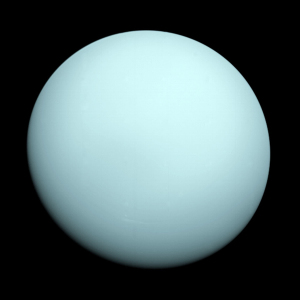Uranus is the seventh planet from the Sun and was the first planet to be discovered in modern times, as it is only just visible to the naked eye.
To find the current position of Uranus in the sky from your location, visit our Night Sky Simulator.
Uranus Stats:
- Type: Ice Giant
- Equatorial Diameter: 51,118 km (4.01 Earths)
- Mass: 8.681×1025 kg (14.54 Earths)
- Distance from Sun: 18.33 AU to 20.11 AU
- Sidereal period (day length): 17 hours 14 min 24 sec
- Orbital period (year length): 84.021 Earth years
- Number of Moons: 27
- Symbol: ♅ (HTML code: ♅)
Uranus, like Neptune, is classed as an ice giant planet and is composed of a rocky core, a layer of ice, followed by a layer of liquid hydrogen and an outer atmosphere of Hydrogen and Helium. A methane cloud deck accounts for the planet’s green colouration. Uranus appears to be fairly featureless in visible light, although it has a faintly brighter polar cap and darker equatorial bands. Bright white clouds of methane ice crystals are occasionally seen in the upper atmosphere.
Discovery of Uranus
In 1781 the musician Sir William Herschel, using a telescope he had built himself, noticed an object that appeared as a non-stellar disk. Originally Herschel though it was a comet or a nebula but, when other astronomers studied the object’s motion, it was found to be a planet. However, Uranus had, in fact, been marked as a very faint star on a number of star charts centuries before this official discovery.
Herschel wanted to call the new planet Georgium Sidus, meaning (King) George’s Star, but astronomers outside of Britain didn’t approve. The planet was eventually given a latinised version of the name of the ancient-Greek sky god, Ouranos, who was the father of Saturn who was, in turn, the father of Jupiter.
Ring System
Like Saturn, Jupiter and Neptune – the other giant planets – Uranus has a planetary ring system composed of at least 13 separate rings. They are composed of dark chunks of material and dust, although one of its outer rings appears red and another appears blue, possibly due to scattering of light by tiny particles or water ice.
Orbital Tilt
Uranus orbits the Sun on its side, with it’s axis of rotation tilted at 97.77 degrees. This is though to have been caused by an impact during the formation of the Solar System. The difference in alignment of the planet’s axis of rotation and its magnetic field results in an unusual corkscrew-like magnetosphere.
Diamond Oceans
It has been proposed that the ice giants Uranus and Neptune could hold oceans of liquid diamond with floating diamond iceburgs and even diamond rain. This could explain why the magnetic field on Uranus is so far out of alignment with it’s axis of rotation, although this is highly speculative, of course.
Uranus’ Moons
Rather than mythological figures, the moons of Uranus are named after characters from the works of Shakespeare. The four largest moons are Titania, Oberon, Umbriel and Ariel. In order of increasing distance from the planet, the 27 known moons are:
